- Home
- Listings
- Things To See & Do
- Car Hire
- News
- Properties
- What’s On
ES
Historic Buildings & Monuments
Historic Buildings, Castles and Monuments on the Costa Tropical
The Costa Tropical boasts a rich tapestry of history woven through its impressive castles and historic sites. From the formidable Almuñécar Castle overlooking the sea to the ancient Phoenician Necropolis of Trayamar, every stone tells a story of the past. Explore the architectural wonders that stand as testaments to the region’s cultural heritage, offering breathtaking views and a fascinating journey through time. Whether you’re drawn to Moorish fortresses or Roman ruins, the Costa Tropical’s castles and monuments promise a captivating glimpse into centuries gone by.
Almuñécar Castle – San Miguel Castle

The most famous historic site on the area. Perched on the San Miguel Hill, with commanding views of Almuñécar, this Arab stronghold occupies a site once utilized by Phoenicians and Romans, evident from various historical sources and remnants of Roman constructions. The castle’s architecture distinctly reflects its Moorish origins, having served as a retreat for the Nasrid dynasty during the 13th century. In the later years of King Ferdinand’s reign in the 16th century, defensive enhancements including a moat, drawbridge, and an imposing entrance façade with four circular towers were added. The castle endured bombardment during the War of Independence against the French by English forces, leaving it in a state of disrepair. It later functioned as a Christian cemetery until the mid-20th century. Notably, a neoclassical pavilion, seemingly unrelated to the castle’s design and possibly constructed in the 18th century, now houses the City Museum.
La Herradura Castle
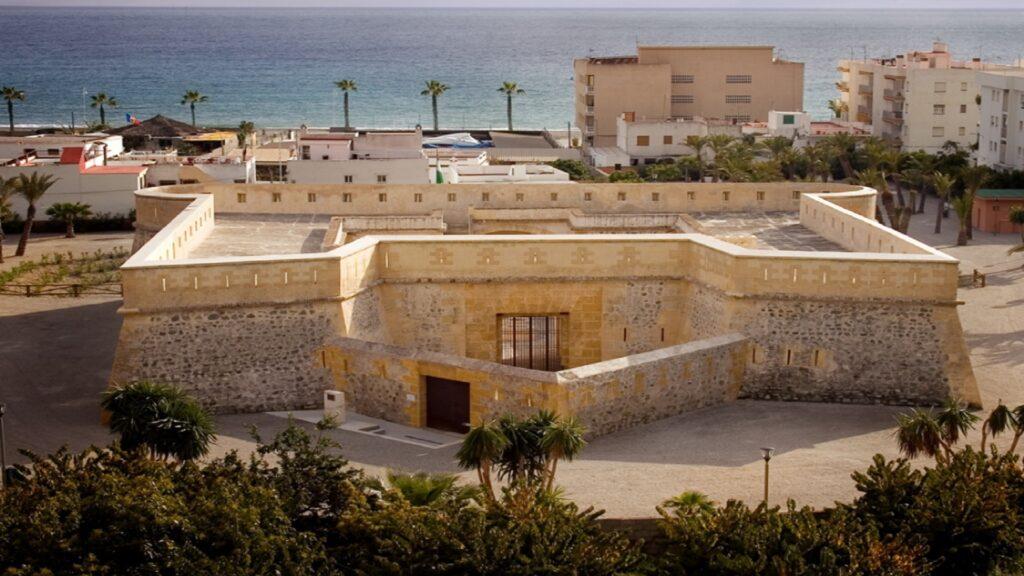
Its building completed in 1771 as as part of improvements in the coastal defense of the former Kingdom of Granada during the reign of Charles III. Its original designation was “Battery for four cannons of La Herradura”.
Currently, it is located in the plain of said locality, as due to coastal regression, its distance to the beach is 120 meters. Its initial placement, closer to the coastline and slightly off-center with respect to the wide bay of La Herradura, was ideal for better protection of the mouth of the Jate River, a water source and quick access point to inland towns. From there, it was possible to repel an attack from the sea or prevent a landing anywhere on its extensive beach.
It was used by the army until 1839, when, after piracy was extinguished, it was handed over to the Carabineros Corps. Their mission was to guarantee the security and surveillance of the coasts and borders, as well as to prevent smuggling. After the dissolution of the Carabineros Corps in 1940, it was occupied by the Civil Guard, which used it as a combined residence and barracks until 2003. Acquired by the Town Hall two years later, it commissioned its restoration and process of museumization.
La Herradura Castle hosts the Centro de Interpretación “1562 La Furia del Mar about the shipwreck of the Armada in 1562 on this area.
Visiting hours:
From Wednesday to Sunday: 10am – 2pm / 5-8 pm
Prices: adults:4 euros, children and pensioners 2 euros, groups (15 people) 1,5 euros
Tickets are on sale up to 45 minutes before closing
Location: Calle Fortaleza 4
Telephone: 958061645
Salobreña Castle
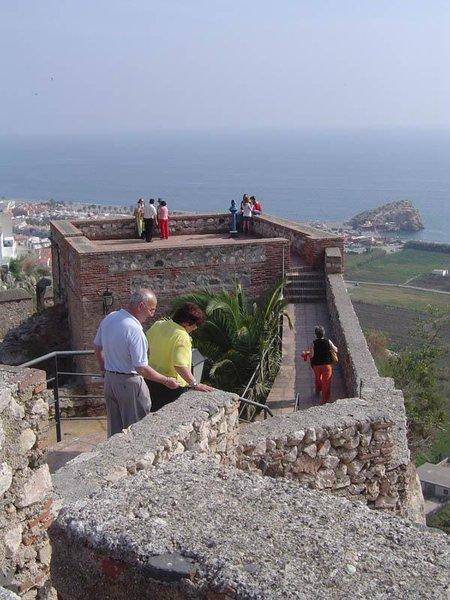
The existence of a fortification in Salobreña has been known since the 10th century. While the layout corresponds to the construction erected during the Nasrid period, the Arab castle is the result of both Muslim and Christian architectural contributions.
During the Nasrid period, it housed a royal palace used for rest, which also served as a royal prison.
The castle was conquered by the Catholic Monarchs in 1489.
The castle retained its military significance until the late 18th century.
Reports from 1739 indicate that it was abandoned and in significant disrepair.
It did not have a specific or utilitarian function, as it did not serve for coastal defense. Nevertheless, the cavalry assigned to the castle had the mission of patrolling from La Caleta to the mouth of the Guadalfeo River.
Starting in 1849, it was used by the customs officers, who established a signaling post within it.
From its towers, one can admire the urban layout of Salobreña, the fertile plain, the Mediterranean Sea, the adjacent mountain ranges, and even Sierra Nevada.
Visiting hours:
June 15-Agust 31: 10am – 1:30pm / 5:30pm – 8pm.
September until last Saturday in October: 10am – 2pm / 5-7:30pm.
Last Sunday in October until- February 28: 10am – 2pm / 4-6pm /
March 1- last Saturday in March: 10am – 2pm / 5-7pm.
Last sunday in March until June 14th: 10am – 2pm / 5:30-8:30pm.
Last access is 30 minutes before the closing.
Closed on December 24th, 25th and 31st, January 1st.
Prices: adults:4 euros, free for children younger than 12 years old
Location: Calle Paseo de las Flores, s/n, 18680.
Telephone: 958610314
El Majuelo fish salting factory
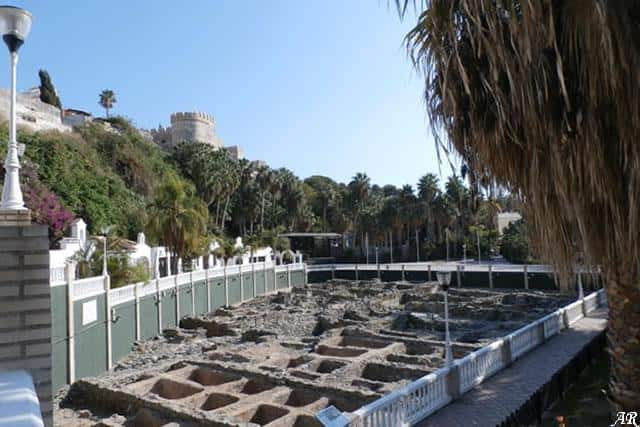
The El Majuelo fish salting factory in Almuñécar is an important archaeological site that highlights the region’s Roman and Phoenician heritage. Located in El Majuelo Botanical-Archaeological Park, this ancient facility was key to fish processing and the production of garum, a prized Roman fish sauce. The factory dates back to the 4th century BCE, with peak activity during the 1st and 2nd centuries CE. Its strategic location near the port yet away from the city minimized odors while ensuring efficient operations. Visitors can explore the preserved salting tanks and learn about Almuñécar’s historical significance in ancient Mediterranean trade.
The factory’s design included central tanks for salting fish, cleaning and storage areas, and administrative spaces. Fresh water was supplied through an aqueduct system, and the tanks were waterproofed using opus signinum, a Roman sealing material. By the 4th century CE, the factory’s use declined, eventually becoming a burial site. Today, visitors can enjoy free access to the site, which is open daily, and experience a fascinating glimpse into Almuñécar’s industrial past and the broader economic activities of the Roman Empire.
Almuñécar Roman aqueduct
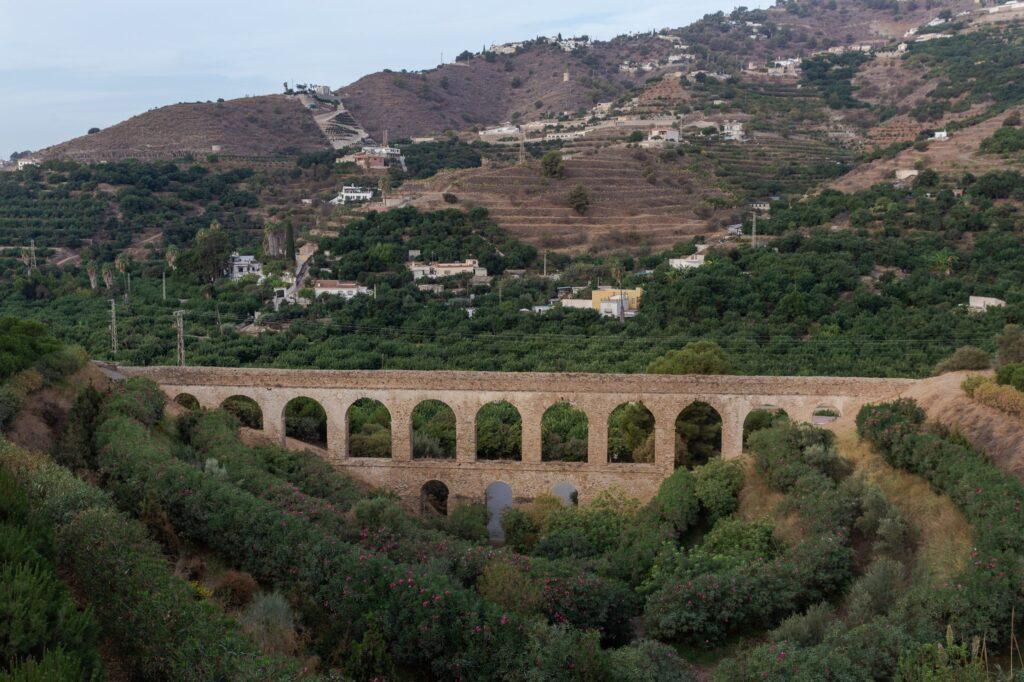
The Roman aqueduct in Almuñécar, built around the 1st century CE, is a remarkable testament to the city’s Roman heritage, alongside the well-preserved fish salting factory. This aqueduct served as a vital water supply for the ancient Roman city of Sexi (now Almuñécar), and later played a role in the Arab irrigation system. Even today, parts of it continue to support traditional irrigation practices, making it the best-preserved Roman aqueduct in Andalusia.
This aqueduct is quite extensive, spanning over 7 kilometers and divided into five distinct sections. Visitors can explore five preserved sections of the aqueduct, including notable stretches like Torrecuevas, La Carrera, and Río Seco. The Carrera section features 12 arches spanning 91 meters, while the Torrecuevas segment, near Río Verde, extends 130 meters and includes the tallest visible portion. Río Seco sections offer stunning countryside views, with arches ingeniously adapted to the natural terrain. The most accessible part is in Carrera de la Concepción, integrated into the town alongside Roman baths. Access to most sections is free, with Parque del Acueducto open from 9 am to 9 pm.
Almuñécar Roman baths
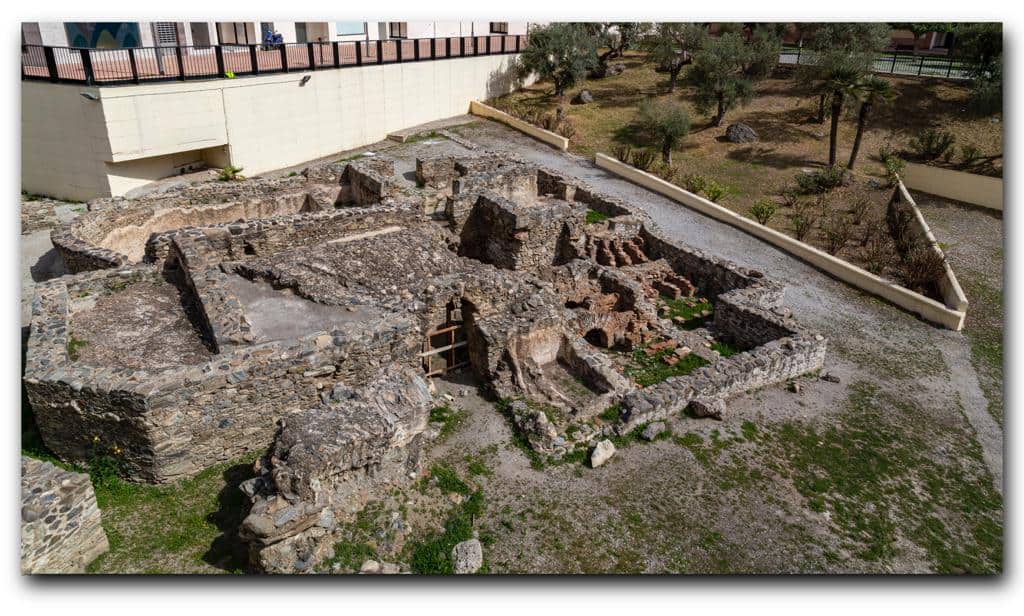
The Roman Baths of Almuñécar, also known as “Termas Romanas,” stand as a remarkable testament to the ancient Roman presence in this coastal town of southern Spain. Situated in the heart of Almuñécar’s historic center, these well-preserved baths offer a fascinating glimpse into the daily life and customs of the Roman inhabitants who once occupied this area.
Believed to have been constructed during the 1st century CE, the Roman Baths are a testament to the advanced engineering and architectural skills of the Romans. This thermal complex served as a vital social and recreational hub for the citizens of Sexi, the Roman name for Almuñécar. Here, residents would gather to relax, socialize, and partake in various health and wellness rituals.
The layout of the baths follows the traditional Roman pattern, comprising different chambers dedicated to specific stages of bathing. Visitors would start in the “caldarium,” a hot room where steam and warm air were used to induce sweating and open pores. This was followed by the “tepidarium,” a warm room, and then the “frigidarium,” a cold room, providing a gradual transition to cooler temperatures. Adjacent to these chambers were spaces for exercise and massage, as well as rooms for socializing.
The architecture of the Roman Baths showcases the Romans’ mastery in utilizing materials like brick and mortar, along with ingenious methods for heating the spaces. The hypocaust system, an underfloor heating system, circulated hot air through the walls and floors to maintain a consistent temperature within the baths.
Today, visitors to the Roman Baths of Almuñécar can explore the well-preserved remains of this ancient complex. The site is thoughtfully curated, with informative displays providing historical context and insights into the Roman bathing customs. As you walk through the chambers, you can envision the bustling activity that once took place here, and admire the architectural details that have stood the test of time.
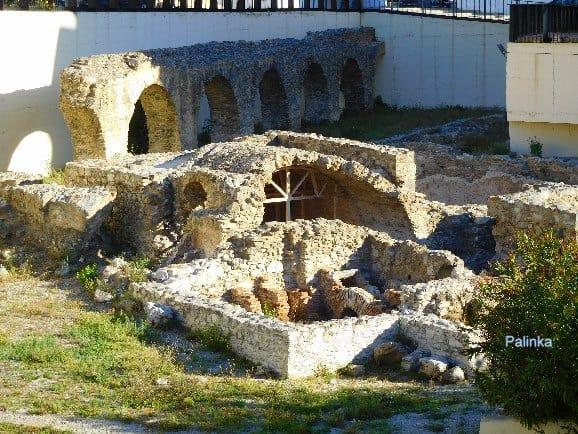
There are regular guided visits organised by the Town Hall. Check their website for details: https://www.visitalmunecar.es/
The Necropolis of Puente de Noy

Another historic landmark of Almuñécar is the Phoenician Necropolis of Puente de Noy. This important archaeological site, active from the 7th century BC to the 1st century AD, reveals the burial practices and rituals of the Phoenician colony of Sexi. Since its discovery in 1979, over 200 tombs containing burial goods, jewelry, and various other artefacts have been uncovered, underscoring the site’s historical and archaeological significance in the region. The site also highlights the fascinating cross-cultural influences between the Phoenicians, Romans, and other Mediterranean civilizations of the time. Located on a hill west of the Río Seco, the necropolis can be accessed by car by driving west from the city centre via the Puerta de Granada street, heading towards the institute. Alternatively, it’s possible to go on foot. While it currently lacks extensive visitor services, it remains an essential stop for anyone interested in exploring Almuñécar’s ancient Phoenician heritage.
Santuario de Nuestra Señora de la Cabeza

The Sanctuary of Our Lady of the Head in Motril holds great spiritual and cultural significance for the local community. Built on the ruins of a Nasrid castle, it was once the residence of Queen Aixa Alhorra, the mother of Boabdil. According to tradition, the Sanctuary of the Virgin of the Head in Motril stems from the legend of Portuguese sailors who, in the early 16th century, stole the image of the Virgin from Corinth. While sailing back to their homeland, they encountered a fierce storm and, fearing for their lives, promised the Virgin to build a hermitage where they would safely disembark. After six days, the ship ran aground in Motril, and true to their promise, the sailors brought the Virgin to the town, erecting a small hermitage on the hill where the ancient ruins of the Muslim fortress once stood.
The temple, constructed from 1631 onwards by Isidro de la Chica, features a Latin cross layout with a single nave, a dome-covered transept, a raised main chapel, and a highly decorated alcove with Baroque plasterwork. Partially destroyed during the Spanish Civil War, it was restored in the mid-20th century, with efforts made to preserve its original structure. The restoration was completed in the 1960s with the altarpiece by the Motrileño sculptor Manuel González Ligero, which synthesizes the values of Motril’s tradition regarding the legend and worship of the Virgin of the Head. The titular image, the Virgin of the Head, the patron saint of Motril, dates back to at least the 15th century and is a magnificent carving in the Mediterranean tradition.
Opening hour: 10am-1pm
Location: Avda. de la Constitución s/n,. Motril
Visitors can explore the vestment room and the tower for a donation of €1.
Casa de la Palma
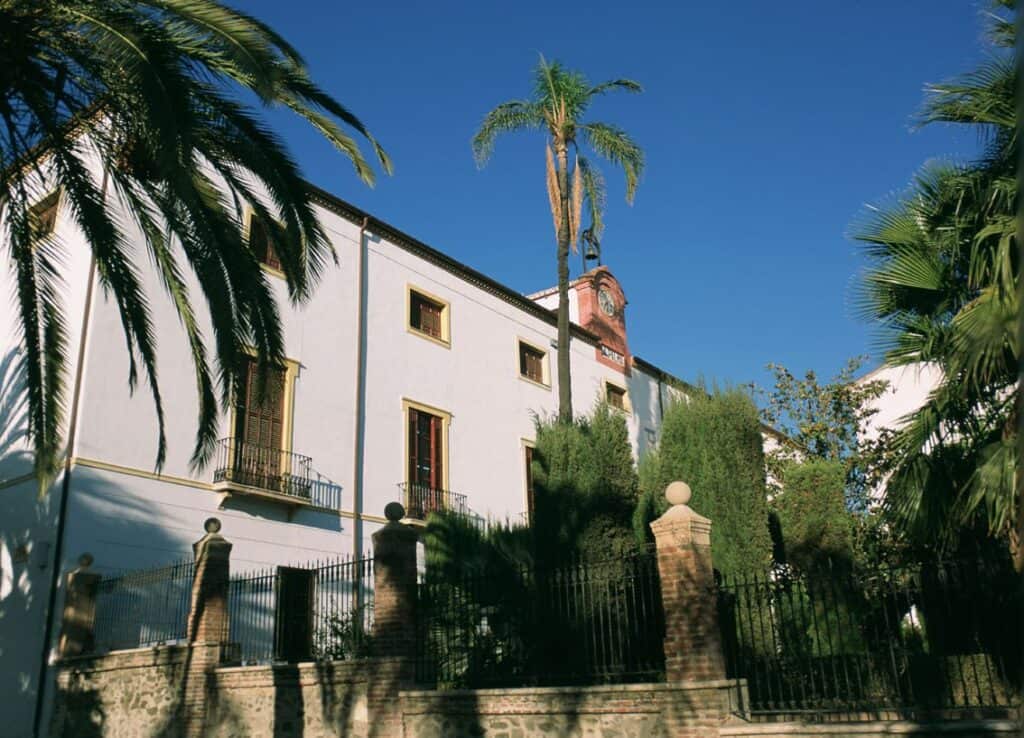
Casa de la Palma is a historic landmark in Motril, recognized for its rich cultural and architectural significance. Built in the 16th century as a sugar mill by Jerónimo Cebtini, it became a key element of the region’s sugar industry. After passing through several hands, including the Victoria family, who added the iconic clock tower in the 19th century, the building gained its aristocratic character. Today, it serves as a cultural center, housing the Preindustrial Sugar Cane Museum, the UNED campus, and municipal archives, offering a unique mix of history and modern educational services.
Beyond its cultural uses, Casa de la Palma also has a fascinating history tied to Spain’s military past. During the French invasion in the early 19th century, the building was used as a prison for captured soldiers. Visitors today can explore its tranquil interior garden, a space designed with plants from the Americas, which adds a serene atmosphere to the site. The cultural complex now includes spaces for exhibitions and events, making it a vibrant hub for both locals and visitors seeking to explore Motril’s past and present.
Columbario de la Torre del Monje

The Columbario de la Torre del Monje is a Roman funerary monument located near Almuñécar. Built in the 1st century AD, it is one of the best-preserved examples of Roman burial structures in the area. The columbarium was declared a Cultural Heritage Site in 1931 and offers a glimpse into Roman burial customs, especially cremation and urn storage. The monument is located on a small hill next to the Verde River, making it easy to visit.
Alhambra Guided Tours
A visit to Granada wouldn't be complete without seeing the Alhambra. Click the button to check out our suggested guided tours.
